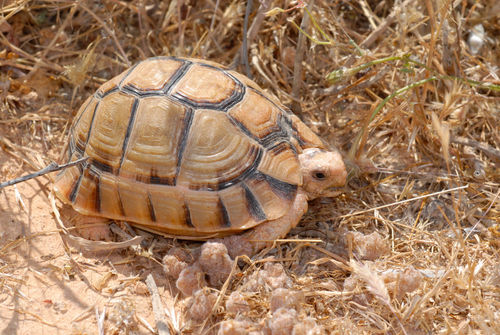
Egyptian Tortoise
The Egyptian tortoise, Testudo kleinmanni, thrives in harsh desert landscapes, blending seamlessly with its sandy surroundings. Its pale shell and resilience in arid climates highlight its unique adaptation, playing a vital role in its ecosystem by aiding seed dispersal. Sadly, it's critically endangered due to habitat loss.
91.0 - 363.0 g
Weight
Length: 8 - 10 cm
Size
Brown, Grey, Yellow, Black, Dark
Color
5 years
Age of Sexual Maturity
Low
Aggression
Critically Endangered
Conservation Status
Decreasing
Population Trend
Characteristics
Testudo kleinmanni, commonly known as the Egyptian tortoise, is a small, herbivorous tortoise native to the deserts of Egypt and Libya. It has a pale, yellowish shell that helps it blend into its sandy environment, aiding camouflage. This species is known for its ability to survive in extremely arid conditions with minimal water.
Distribution Range of the Egyptian Tortoise
Testudo kleinmanni, commonly known as the Egyptian tortoise, is native to the North African region, specifically found in the coastal regions of Libya and Egypt. Historically, its range extended into Israel, but the species is now considered extinct in the wild in that area.
Egyptian Tortoise's Habitat
Environmental Conditions
The Egyptian tortoise inhabits arid desert and semi-desert environments. It is typically found in areas with sparse vegetation, such as sandy and gravelly plains, coastal dunes, and rocky outcrops. The climate in these regions is characterized by high temperatures and low humidity, with minimal rainfall.
Ecological Niche
This species is well-adapted to survive in harsh desert conditions. It is primarily herbivorous, feeding on a variety of desert plants, including grasses and succulents. The Egyptian tortoise is most active during the cooler parts of the day, such as early morning and late afternoon, to avoid the extreme heat. Its adaptations include a light-colored shell that reflects sunlight and a behavior of burrowing into the sand to escape high temperatures.
Copyright @ Nature Style Limited. All Rights Reserved.
 English
English